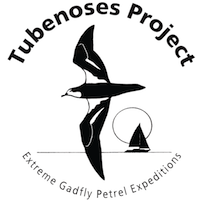The Ultimate Western Palearctic Pelagic Expedition: Madeira, May 2010
The Ultimate WP Pelagic Expedition: Madeira, May 2010
3-13 May, 2010
With the first video of Zino's Petrel at sea
Expedition report by Hadoram Shirihai (Tubenoses Project / Extreme Gadfly Petrel Expeditions), with Catarina Fagundes and Hugo Romano (Madeira Wind Birds / Oceanodroma), and Frank Zino and Manuel José Biscoito (Freira Conservation Project (FCP) & Municipal Museum of Funchal)
The first-ever film of the Zino's Petrel at sea (Video by Hugo Romano, Madeira Wind Birds / Oceanodroma)
During last year's pelagic expeditions (April and June 2009—see reports on this website) I thought that we had achieved the ultimate in petrel studies. During the course of one 24-hour period, I had (together with Frank) handled Desertas Petrels on Bugio and Zino's Petrels on the summit of Madeira (during licensed nocturnal studies), while by day I had photographed (with Catarina) the two species side-by-side in the ocean, together with an inquisitive Sperm Whale approaching the chum.
I am writing this report while still in Madeira. Because I had still not photographed at sea (though Frank had captured several) the 'white-winged' type Zino's, and because I had only observed twice the 'snowy-winged' type petrel (of Zino's?), I decided to return here with Madeira Wind Birds, in an effort to photograph these distinctive plumage types at sea. Although the expedition is not yet over, I can report that the 'excitement' of working on these petrels at sea off Madeira has reached even greater heights for three reasons.
- Catarina and Hugo have now got the best boat for pelagic trips, named Oceanodroma, and these two 'enthusiastic youngsters' are keen to show birders the islands' rarest petrels and to conduct research into these birds at sea. During the past week, we have also discussed how Oceanodroma can achieve the twin goals of pelagic birding and research. I am confident that in the former, their operation will soon be accepted as the ultimate pelagic in European waters, which every birder should experience!
- We must always remember that Zino's Petrels survive due to the massive personal 'investment' of the Zino family, and especially Frank Zino and Manuel José Biscoito. My dream has now been achieved—to watch with Frank Zino 'his' petrel flying in the ocean. Frank was at the time piloting the boat, while Hugo was videoing the petrel and the event— Frank's face expressed his shock, and he said "Next time, I should bring my butterfly net to capture these Zino's to check the ring numbers".
- It has taken me (with the special assistance of Madeira Wind Birds) considerable time to establish how to find Zino's Petrel at sea and to study them there. This year the hard work and determination are paying off. We now know where and when to go to find Zino's Petrels at sea. It was also a pleasure to get to know better Manuel José Biscoito. He has also devoted much of his life to conserving Madeira's wildlife, especially Zino's Petrel and Mediterranean Monk Seal.
Madeira Wind Birds' team, during the Zino's Petrel operation at sea, on the Oceanodroma ... (Video by Hugo Romano, Madeira Wind Birds / Oceanodroma)
Before coming to the results from this year, I would like to emphasise that these observations relate to two forthcoming papers that form part of our long-term studies into the feae complex: Shirihai, H., Bretagnolle, V. & Zino, F. (Ill. by John Cox) (in press) Pelagic identification of the northeast Atlantic gadfly petrels. Birding World 23; and Bretagnolle, V., Zino, F., Gangloff, B., González-Solís, J. & Shirihai, H. (in prep.) Taxonomy, variation and conservation of the complex of gadfly petrels (Pterodroma feae, madeira, deserta) from the northeast Atlantic. They will also contribute to the ongoing global book project: Shirihai, H. & Bretagnolle, V. (Ill. by John Cox) (in prep.) Albatrosses, petrels and shearwaters of the world: a handbook to their taxonomy, identification, ecology and conservation. Christopher Helm, London.'
Diary:
3 May, chumming north of the island at location "Zino's A" 15.20-20.00 h.
Sea conditions
10-15 knots wind, generally northerly (N-NE) most of the day; mostly cloudy, with the island only occasionally visible.
Observers
Hugo, Frank and myself.
Seabirds observed Zino's Petrel Pterodroma madeira 1 (+ 1 'presumed' Zino's): one (petrel 1) on the chum (very close and photographed) at 17.25 h; the other (petrel 2) on the return at 20.45 h, approaching close to the island before dark (regarded as 'presumed Zino's', due to the observation conditions and lack of photographic confirmation).
Other tubenoses:
Bulwer's Petrel Bulweria bulwerii
30+, Cory's Shearwater Calonectris (diomedea)
borealis 70+, Manx Shearwater Puffinus puffinus
6, Madeiran Storm Petrel Oceanodroma [castro] 15,
Wilson's Storm Petrel Oceanites oceanicus
2, White-faced Storm Petrel Pelagodroma marina 3.
Hadoram during studies of the Zino's a sea: first look (learn and enjoy), then take a photo of the Zino's Petrel... (Video by Hugo Romano, Madeira Wind Birds / Oceanodroma)
4 May, chumming north of the island at location "Zino's A" 15.35-20.00 h.
Sea conditions
15 knots wind, generally NE most of the day; partially cloudy, but the island was again only occasionally visible.
Observers
Catarina, Hugo and myself.
Seabirds observed Zino's Petrel Pterodroma madeira 3 (+ 1 'presumed Zino's'): 3 on the chum at 16.51 h (petrel 3), 18.48 h (petrel 4), 19.49 h (petrel 5)—all seen close and confirmed photographically; and the other (petrel 6) on the return at 21.10 h, approaching close to the island before dark (regarded as 'presumed Zino's', due to the observation conditions and lack of photographic confirmation).
Other tubenoses:
Bulwer's Petrel Bulweria bulwerii
50+, Cory's Shearwater Calonectris (diomedea)
borealis 200+, Manx Shearwater Puffinus puffinus
5, Madeiran Storm Petrel Oceanodroma [castro] 20 (one tailless), Wilson's Storm Petrel Oceanites oceanicus
1, British Storm Petrel Hydrobates pelagicus 1 (in moult),
White-faced Storm Petrel Pelagodroma marina 4.
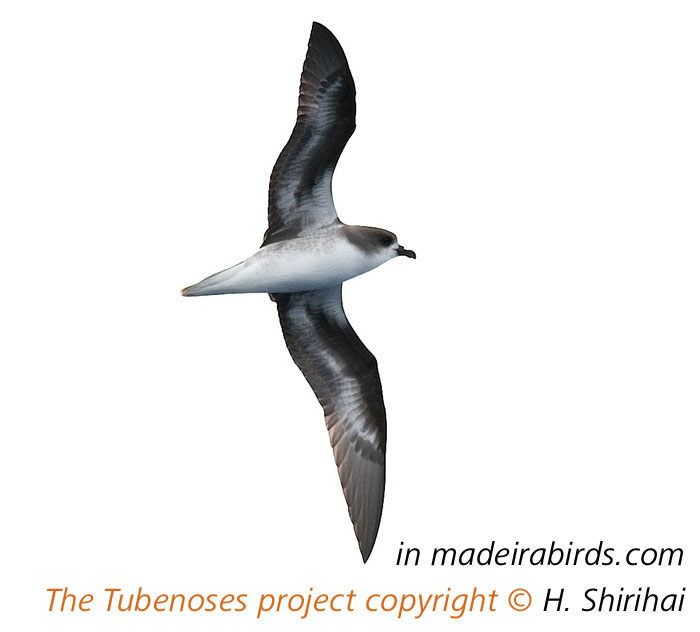
The Zino's Petrel on 3 May (petrel 1), when I had the pleasure to have Frank Zino on board, observing 'his' rare petrel at sea, after years of conservation effort (Photo by Hadoram Shirihai, Tubenoses Project / Extreme Gadfly Petrel Expeditions)
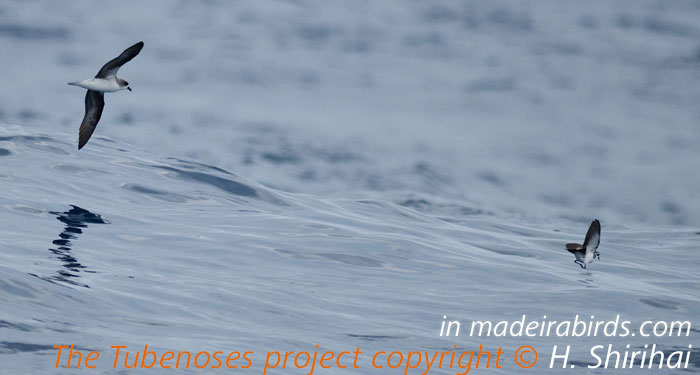
Zino's Petrel (petrel 5) and White-faced Storm Petrel, which two species are the key subjects of our research in Madeiran waters (Photo by Hadoram Shirihai, Tubenoses Project / Extreme Gadfly Petrel Expeditions)
5 May, chumming north of the island at location "Zino's A" 15.35-20.30 h.
Sea conditions
5-10 knots wind generally NE most of the day; partially cloud, but the island was usually visible from our position.
Observers
Catarina and myself.
Seabirds observed Zino's Petrel Pterodroma madeira none on the chum but 1 'presumed Zino's' (petrel 7) flushed from the water en route at 21.00 h, rather close to the island before dark (regarded as 'presumed Zino's' due to observation conditions and no photographic evidences).
Other tubenoses:
Bulwer's Petrel Bulweria bulwerii
90+, Cory's Shearwater Calonectris (diomedea)
borealis 150+, Manx Shearwater Puffinus puffinus
12, Barolo's Shearwater P. (lherminieri
/ assimilis) baroli 1 (good images), Leach's Storm Petrel Oceanodroma leucorhoa 1 rather worn bird with limited white rump patch, Madeiran Storm Petrel O. [castro] none, British Storm Petrel Hydrobates pelagicus 3 (rather good images—again all with extremely white underwing-coverts as we noticed last year*), White-faced Storm-petrel
Pelagodroma marina 3.
*My friend Tony Pym, who has observed the species extensively, confirmed that this amount of white in the underwing-coverts can be seen among local breeders in the UK. However, it will be interesting to check the frequency of this 'type' of pelagicus in Madeiran waters compared to breeders in continental European populations. It was also a good opportunity to learn how the amount of white in the coverts appears to vary with the light. In cloud or low light, the white is more obvious and appears most extensive, whereas in sunny condition when the underwing is in shadow, it is the white on the secondary coverts that is most apparent (thus the overall area of white seems smaller). This was also useful practice for evaluating the extent of white on the underwing in studies of other storm petrels.
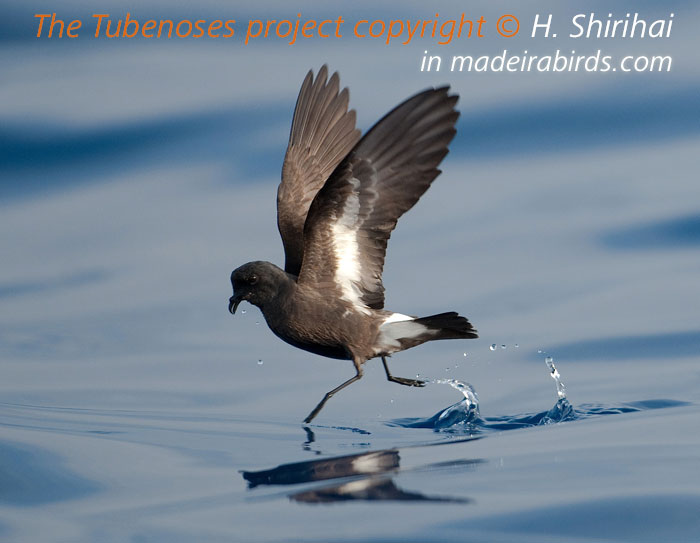
British Storm Petrel, with extensive white underwing-coverts (see main text) (Photo by Hadoram Shirihai, Tubenoses Project / Extreme Gadfly Petrel Expeditions)
6 May, chumming north of the island at location "Zino's B" 15.06-20.00 h.
Sea conditions
Max. 5 knots wind (almost calm and very slight swell), and generally sunny to partially cloudy most of the day; the island was visible much of the time.
Observers
Hugo, Manuel and myself.
Seabirds observed Bulwer's Petrel Bulweria bulwerii
30+, Cory's Shearwater Calonectris (diomedea) borealis 150+, Manx Shearwater Puffinus puffinus
8, Madeiran Storm Petrel Oceanodroma [castro] 1,
British Storm Petrel Hydrobates pelagicus 1, White-faced Storm Petrel Pelagodroma marina 1.
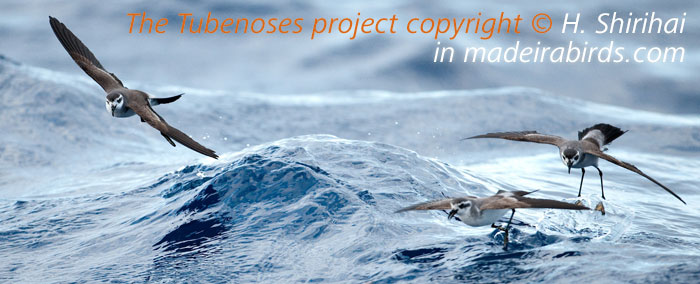
White-faced Storm Petrel, in 'dancing' postures while feeding—Madeira is now the best site to observe the species in Europe. (Photo by Hadoram Shirihai, Tubenoses Project / Extreme Gadfly Petrel Expeditions)
7 May, due to lack of wind and petrels in the last two days we took a day off.
8 May, today the wind (and sea) were from the west, meaning that we could only go slowly and we only reached location "Zino's C", 15.00-20.30 h.
Sea conditions
15-22 knots wind, generally westerly; partially cloudy, but the island was visible constantly.
Observers
Hugo, Manuel and myself.
Seabirds observed Zino's Petrel Pterodroma madeira 1 (+ 1 'presumed Zino's' and 5 'Zino's/Desertas'), representing the largest number of Pterodroma
in one day so far on the expedition: one (petrel 8) en route at 14.33 h (close view and confirmed with photos); and 6 on the chum, at 17.51 h (3 petrels 9-11—only bird 9 was photographed well and its bill was 'borderline', thus treated as a 'presumed Zino's', and the other two as 'Zino's/Desertas'), 18.35 h (petrels 12-13—views were more distant and no photos, thus both were treated as 'Zino's/Desertas'), and 19.37 h (petrel 14—photographed well, but its bill size was borderline, thus treated as 'Zino's/ Desertas').
Other tubenoses:
Bulwer's Petrel Bulweria bulwerii
100+, Cory's Shearwater Calonectris (diomedea)
borealis 1,000+ (with two huge feeding frenzies), Manx Shearwater
Puffinus puffinus 40+, Barolo's Shearwater P. (lherminieri
/ assimilis) baroli 1 (good images), Leach's Storm Petrel Oceanodroma leucorhoa 1, Madeiran Storm Petrel
O. [castro] 2, Wilson's Storm Petrel Oceanites oceanicus 2, and White-faced Storm Petrel Pelagodroma marina max. 7 at once, and a total number of perhaps nearly 20! (the largest number ever observed off Madeira).
During this great day for bulwerii, we also saw a very bizarre Bulweria (see photo). Compared to B. bulwerii, it was clearly heavily built (but not overall larger or smaller) with a distinctive dumpy body, shorter / thicker neck, large round head, and with clearly shorter / broader / rounder wings and tail. Together with its very different flight and feeding behaviour, it had a very distinctive appearance. Overall, its dumpy appearance sometimes afforded it the jizz of Great-winged Petrel Pterodroma macroptera. At sea (and in the photos) the bill was clearly deeper than normal bulwerii, otherwise the overall size and plumage was as bulwerii, so I am sure the bird was NOT Jouanin's Petrel B. fallax.
The bird appeared twice at the chum, each time for 10-20 minutes, which is also odd as many bulwerii visit the chum very briefly (and depart after a few seconds). Unlike the other bulwerii it fed more like a storm petrel (constantly 'walking' on the water while feeding). Although bulwerii also often 'stands' on the water, with partially open wings, I have never seen them 'habitually' doing so for extended periods like this odd bird! Consequently, the bird acquired an oily face from the chum. I could easily distinguish the bird by its shape and behaviour from the many bulwerii seen today, even without binoculars.
Perhaps this is just a very odd bulwerii, but I have never seen bulwerii behaving like this and of such bulk. Thus, tentatively, I see two possibilities.
1 This is just an odd bulwerii (i.e. individual variation), especially given how extensively these petrels can vary individually in their shape and behaviour (which option seems more plausible, given that certain individuals can behave differently due to certain circumstances and therefore possess a different shape ... just like some people). Or, 2 there is some unidentified geographical variation in bulwerii. I wonder if, perhaps like the O. castro complex, there is some inter-island variation that has not yet been appreciated? Normally people see bulwerii at long range and briefly, but our chumming is bringing bulwerii very close in large numbers and I am learning about the variation.
My hope is that this observation will encourage a closer look at bulwerii, while Frank, Vincent and I are already conducting extensive research into specimens, live birds at colonies and at sea, as we are also doing with other petrels.
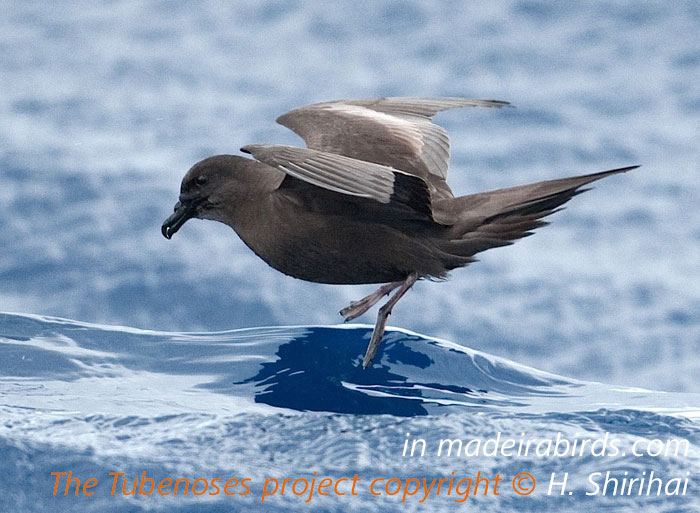
bizarre-looking Bulwer's Petrel (see main text): we still know nothing about the variation of this widespread but somewhat obscure seabird (Photo by Hadoram Shirihai, Tubenoses Project / Extreme Gadfly Petrel Expeditions)
9 May, due to the lack of wind (but also exhaustion) we took a day off.
11 May, another amazing day at sea. The forecast was for max. 10 knots wind, so we decided to visit the 'hotspot', chumming location "Zino's D" (where I encountered both Desertas and Zino's Petrels side-by-side in 2009). Although we arrived rather late, it was immediately clear that there were many birds; 15.55-20.30 h.
Sea conditions
max. 22 knots until 16.00 h, after which it dropped to 8-10 knots until evening (generally NE most of the day); sunny and partially cloudy, with the island usually visible.
Observers
Catarina, Hugo and myself.
Seabirds observed Zino's Petrel Pterodroma madeira
1 (+ 1 'presumed Zino's' and 1 'Zino's/Desertas'): one (petrel 15—photographed, was borderline in bill size, thus treated as 'presumed Zino's') at 15.43 h, 1 at 16.37-16.43 (petrel 16—photographed well and confirmed as 'white-winged' type Zino's), and 1 at 18.19-18.40 (petrel 17—photographed well, but borderline in bill size and overall shape and size, thus treated as 'Zino's/ Desertas').
Other tubenoses:
Bulwer's Petrel Bulweria bulwerii
40 (max.) observed at once on the chum, with a conservative min. total of 200+, Cory's Shearwater Calonectris (diomedea)
borealis 100+, Manx Shearwater Puffinus puffinus
5, Leach's Storm Petrel Oceanodroma leucorhoa 1,
Madeiran Storm Petrel O. [castro] 1, Wilson's Storm Petrel Oceanites oceanicus
1, British Storm Petrel Hydrobates pelagicus 2, and
White-faced Storm Petrel Pelagodroma marina 6.
As we arrived (15.40 h) there was already a petrel 'waiting' for us, so we followed it for c.6 minutes (see above: petrel 15). Then on the chum, we had the 2 'longest-staying' petrels yet—1 (petrel 17) for almost 20 minutes, which gave us a great opportunity to observe their feeding behaviour. Amazingly, most feeding attempts at the surface were by chasing Bulwer's Petrels and trying to steal food from them; 6 times one managed to force the Bulwer's to drop the food and to collect it from the water, and even once in the air. Such parasitic behaviour is known in very few petrels, but they were the most aggressive attacks that I have seen in any Pterodroma petrels!
These observations are highly important, given how very little we know about the oceanic behaviour of the feae-complex. It has taken me three seasons to discover where and how to find Zino's at sea. Now we may even start to learn about their pelagic behaviour. Although I had already observed both Fea's and Desertas Petrels threatening smaller petrels and even larger gulls, I had never seen them forcing other species to drop their food as this Desertas/Zino's did today.
Today I also finally photographed a 'white-winged' Zino's, but not the 'snowy-winged' one that I saw in 2008 (the first Zino's at sea).
13 May, the last day and today I was feeling very exhausted and had a strong migraine, but it proved to be a very productive petrel day. Moreover, we also saw a very pale petrel that might have been the 'snowy-winged' type Zino's (or something else—see below). The sea was rather rough and the waves high, so we elected to visit the closer 'hotspot' "Zino's C" (where we had seven petrels on 8 May); 15.45-20.30 h. My DX3 Nikon camera became seriously wet and to some extent damaged due to the waves, and for the second time in the past 6 months was causing technical problems, not only to shoot pictures but also to review the images. However, I managed to photograph about half of the petrels today.
Sea conditions
max. 17 knots until 16.00 h, after which it dropped to c.10 knots until evening (generally N-NE most of the day); sunny and partially cloudy, with the island partially visible.
Observers
Hugo, Manuel and myself.
Seabirds observed Pterodroma
petrels 11, of which 4 were identified as Desertas deserta, 1 as 'presumed Desertas', 5 as 'Zino's/ Desertas' (madeira/ deserta), and one unidentified very pale petrel (petrel 19— see below), providing a new Pterodroma
peak for this expedition. It is now clear that Desertas have returned! The first petrel (petrel 18—'presumed Desertas', photographed: a rather heavy bird, but the bill appeared borderline, thus it was most probably a small-billed Desertas) was seen en route at 14.41 h; the other 8 were on the chum, with 1 at 16.27 h (petrel 19, an very odd, pale and white-winged petrel—photographed, see below), 19.20 h (petrel 20—Desertas, photographed), 19.31-19.46 h (3 petrels 21-23, providing 15 minutes of action—all Desertas, photographed), 19.55 h (petrel 24—bill and overall size seemed good for Zino's, but no photos so treated as 'Zino's/Desertas'), 20.04 h (2 petrels 25-26—not close and no photographs, so treated as 'Zino's/Desertas'), 20.18 h (petrel 27—bill and overall size seemed good for Zino's, but only poor photos, so placed as 'Zino's/Desertas'), and the last (petrel 28—due to poor light conditions no photos were taken, so also treated as 'Zino's/ Desertas') on the return at 21.15 h, approaching close to the island before dark.
Other tubenoses:
Bulwer's Petrel Bulweria bulwerii
300+ (see below), Cory's Shearwater Calonectris (diomedea)
borealis 250+, Manx Shearwater Puffinus puffinus
12, Leach's Storm Petrel Oceanodroma leucorhoa 2,
Madeiran Storm Petrel O. [castro] 4, and White-faced Storm Petrel Pelagodroma marina 6.
Today was one of the most remarkable 'petrel days' in recent times (the chum slick was 'boiling' with Bulwer's Petrels, of which more below), whilst the Pterodroma action was outstanding, with the highlight, of course, the observation of a very pale petrel was perhaps the 'snowy-winged' that I first saw in 2008 (and again with John Cox in 2009). It was a pleasure to practice separating the returning Desertas Petrels from Zino's Petrels...
I am now in conflict with myself as to the characteristics of the 'snowy-winged' type petrels (including petrel # 19): are these distinctive petrels Zino's? Probably yes, but why do they possess their own characters? The main issue is that beside the reduced diagonal bar on the underwing, they have white bases to the inner webs of the primaries, which are never shown by other Zino's (even the palest), or by any other members of the feae complex. The colour of the underside of the remiges is normally specific in character, yet there is no such underwing pattern for any petrel in the world! Conservatively, I think the 'snowy-winged' type petrels (three sightings, but perhaps all of the same individual) are still best regarded as an odd (or aberrant) Zino's, but can we certainly eliminate the possibility that it is another taxon in the
feae complex or even of another group? Extremely pale Trindade Petrel
Pterodroma arminjoniana also came to my mind because in the Atlantic only the latter and Kermadec Petrel P. neglecta possess such white bases to the primaries, but I tend to exclude this possibility on upperparts coloration: our 'snowy-winged' petrel has a feae complex pattern. Trindade has essentially dark/uniform upperparts and upperwings... What are the other possibilities? We should be open to anything...
Thus, Frank, Vincent and I will have to explain these issues in our forthcoming
Birding World paper, and thereafter we will continue to update the
Wind Birds website with information, photos and videos of this 'snowy-winged' type petrel.
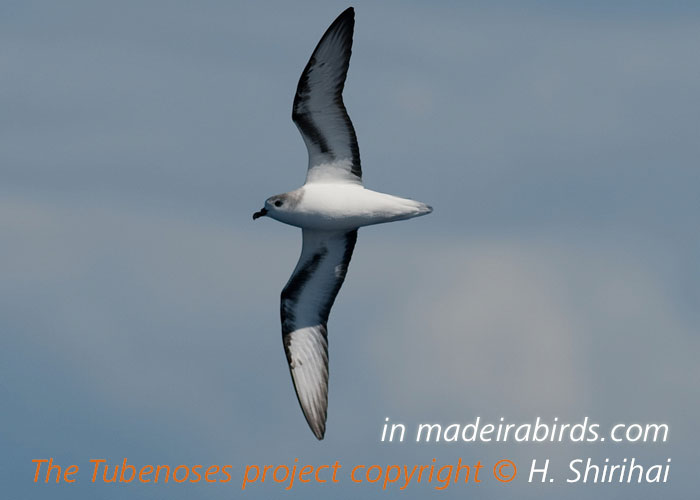
Unidentified Pterodroma Petrel, petrel 19 (see text): the so-called 'snowy-winged' type petrel — could this be an extreme/aberrant variant of Zino’s or Trindade Petrel, or something else? (Photo by Hadoram Shirihai, Tubenoses Project / Extreme Gadfly Petrel Expeditions)
Unidentified Pterodroma Petrel, petrel 19 (see text): a 'snowy-winged' type petrel—photographed and filmed on the 13th May 2010. This is the third sighting of such odd looking petrel in Madeiran waters, which Madeira Wind Birds / Oceanodroma will continue to search for (Video by Hugo Romano, Madeira Wind Birds / Oceanodroma)
Today, I also began to sort out the 'messy' issue concerning the appearance of Bulwer's Petrels, by watching a great many of them for at least 2 hours and photographing c.50 individuals. During certain winds (speed and direction) some bulwerii (only single individuals amongst the many) adopt a different feeding method, remaining on the chum for some time and 'stepping' / 'walking' on the water in a storm petrel fashion. At such times, they possess a more rounded wing and squatter overall jizz, and even look smaller. Nevertheless, none possessed the distinctive bulk of the Bulweria on 8 May. As mentioned under the account of that day, I still regard the latter as just an odd-looking bulwerii, and I decided to maintain my comments above to demonstrate how we are still learning...
To conclude, all in all during 3-13 May 2010 (seven days at sea) we encountered 28 Pterodroma petrels, of which we identified (with photographic confirmation) 6 Zino's Petrels. We also identified 5 as 'presumed Zino's Petrels', 11 as 'Zino's/Desertas', 1 'presumed Desertas', 4 as Desertas, and an odd and extreme pale petrel (petrel 19), which is perhaps 'snowy-winged' Zino's. Readers and future observers on the Oceanodroma should understand that the above observations represent ongoing research into the possible at-sea separation of Zino's Petrel from Desertas Petrel. The Oceanodroma team will continue these observations while taking birders to share the excitement and challenge these fascinating seabirds present.
I end this report by again thanking the many great people of Madeira for their great cooperation and hospitality: Buffy & Frank Zino, Catarina Fagundes, Hugo Romano and Manuel José Biscoito. Finally, thanks to Bill Bourne for commenting on the strange Bulweria and Guy Kirwan for editing this report.
We are driven by the petrels...
Hadoram Shirihai,
Tubenoses Project / Extreme Gadfly Petrel Expeditions ©
